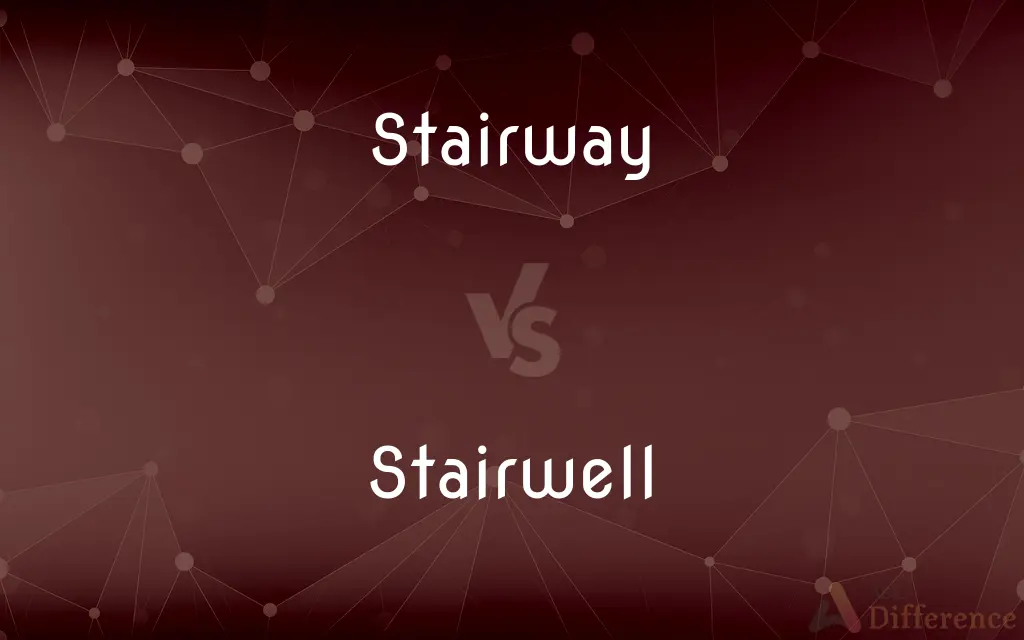Stairway vs. Stairwell — What's the Difference?
By Maham Liaqat & Fiza Rafique — Updated on February 29, 2024
Stairway refers to a set of steps providing passage between different levels, while a stairwell is the vertical space enclosing a staircase.

Difference Between Stairway and Stairwell
Table of Contents
ADVERTISEMENT
Key Differences
Stairways are integral architectural features that facilitate vertical movement within buildings, consisting of a series of steps connecting different floors or levels. Stairwells, in contrast, encompass the void or shaft surrounding a staircase, often including the stairway itself, and can serve as a means of ventilation or access for light in a building.
The primary function of a stairway is to provide a path for ascent or descent between floors, while the stairwell has a broader role, potentially serving as a fire escape route and housing the stairway within its confines. This distinction highlights the stairway's focus on practical utility and the stairwell's additional architectural and safety functions.
Stairways can be designed in various styles and materials, reflecting aesthetic and functional considerations specific to the building they are part of. Stairwells, however, might be designed with safety, space efficiency, and structural integrity in mind, emphasizing the importance of the enclosing space over the staircase itself.
The term "stairway" emphasizes the physical steps and their arrangement, whereas "stairwell" brings attention to the surrounding space, which can be a critical aspect of building design, especially in terms of emergency access and egress.
In usage, stairways are often mentioned in the context of their accessibility or design features, such as being steep or ornate. Stairwells, on the other hand, might be described in terms of their dimensions, lighting, or ventilation qualities, underscoring their role in the overall building environment.
ADVERTISEMENT
Comparison Chart
Definition
A set of steps for moving between different levels
The vertical space enclosing a staircase
Primary Function
Facilitate vertical movement
Enclose the staircase, provide access and safety
Design Focus
Steps and their arrangement
Space efficiency, safety, and structural integrity
Architectural Role
Connect floors within a building
Serve as a means of ventilation or light
Safety Features
May include handrails, non-slip treads
Often designed as fire escape routes
Compare with Definitions
Stairway
A series of steps designed for the purpose of connecting different levels within a structure.
The marble stairway added a touch of elegance to the historic building.
Stairwell
Often highlighted for its role in emergency evacuations.
Fire drills emphasize the importance of the stairwell for safe building exit.
Stairway
Can be ornate or simple, depending on the architectural style.
The modern home boasted a minimalist stairway with floating steps.
Stairwell
Can be a significant architectural element, especially in tall buildings.
The architect designed the stairwell to act as a thermal chimney, aiding in natural ventilation.
Stairway
Includes features like handrails and anti-slip surfaces for safe use.
The stairway was retrofitted with handrails to meet safety codes.
Stairwell
The enclosed space around a staircase, extending vertically between building floors.
The stairwell was brightly lit, ensuring visibility at all times.
Stairway
Refers specifically to the physical steps and their layout.
The old house featured a narrow, winding stairway that led to the attic.
Stairwell
Focuses on the structural and safety aspects of enclosing staircases.
The stairwell's design incorporated glass walls for a modern look and feel.
Stairway
Often described by its position within a building or landscape.
A hidden stairway behind the library connects to the garden.
Stairwell
Serves multiple purposes including safety egress, ventilation, and natural light access.
The building's stairwell doubles as an emergency exit in case of fire.
Stairway
See staircase.
Stairwell
A shaft in a building in which a staircase is built
The stairwell echoed with the sounds of pounding feet
Stairway
A set of steps, with or without a case, that allow one to walk up or down.
The phrase "stairway to heaven" has a variety of cultural significances.
Stairwell
A vertical shaft around which a staircase has been built.
Stairway
A flight of stairs or steps; a staircase.
Stairwell
A shaft in a multi-story building enclosing a stairway or staircase.
Stairway
A way of access consisting of a set of steps
Stairwell
A vertical well around which there is a stairway
Common Curiosities
Can stairwells be used for purposes other than housing staircases?
Yes, stairwells can provide ventilation, light access, and even serve as social or communal spaces in some designs.
What is the main difference between a stairway and a stairwell?
A stairway consists of the steps themselves, while a stairwell is the enclosed space surrounding the staircase.
Is the stairwell important for building safety?
Absolutely, stairwells are crucial for safety, often serving as protected emergency exits.
How do stairwells aid in emergency evacuations?
Stairwells offer a protected route out of a building, free from smoke or fire in many cases.
Can a building have a stairway without a stairwell?
Yes, outdoor or open stairways may not have an enclosing stairwell.
What are some common safety features of stairways?
Handrails, anti-slip treads, and adequate lighting are common safety features.
Can the design of a stairway affect a building's overall aesthetic?
Definitely, stairways can be key aesthetic elements, reflecting the architectural style of the building.
Why might a stairwell have ventilation features?
Ventilation in stairwells can improve air quality and aid in smoke clearance during emergencies.
Are there regulations governing the design of stairways and stairwells?
Yes, building codes and regulations set standards for their design, focusing on safety and accessibility.
Can a stairwell be a focal point in architecture?
Yes, in many modern designs, stairwells are architectural highlights, offering aesthetic and functional benefits.
How do design considerations differ between stairways and stairwells?
Stairway design focuses on the steps and usability, while stairwell design prioritizes space use, safety, and structural needs.
How can stairways be made more accessible?
Adding features like handrails on both sides, gentle slopes, and rest landings can improve accessibility.
How are stairwells integrated into building safety codes?
Safety codes may dictate stairwell construction standards, including width, lighting, and access to ensure they serve as effective emergency exits.
How do architects balance the aesthetic and functional aspects of stairways and stairwells?
Through careful planning and design, ensuring both elements meet safety standards while contributing to the building's overall look and feel.
What role does lighting play in stairwell design?
Adequate lighting is essential for safety and navigation within stairwells.
Share Your Discovery

Previous Comparison
Topic vs. Title
Next Comparison
Linctus vs. SyrupAuthor Spotlight
Written by
Maham LiaqatCo-written by
Fiza RafiqueFiza Rafique is a skilled content writer at AskDifference.com, where she meticulously refines and enhances written pieces. Drawing from her vast editorial expertise, Fiza ensures clarity, accuracy, and precision in every article. Passionate about language, she continually seeks to elevate the quality of content for readers worldwide.














































